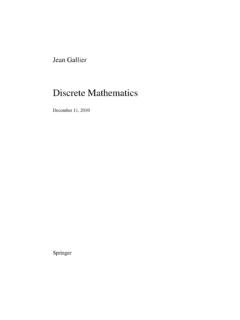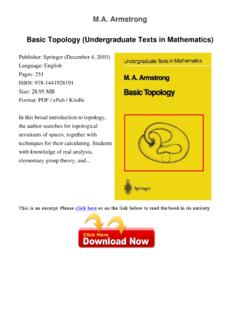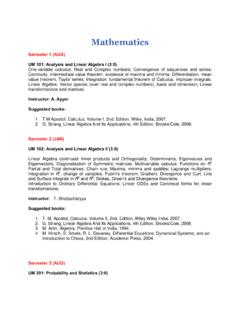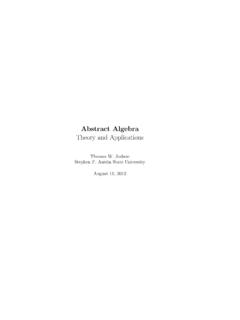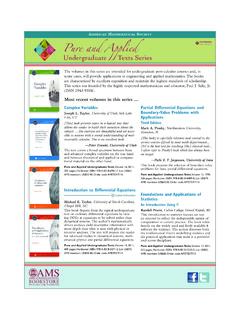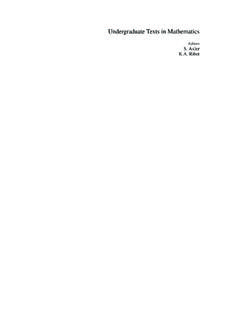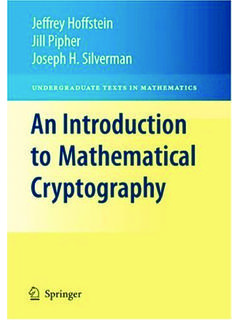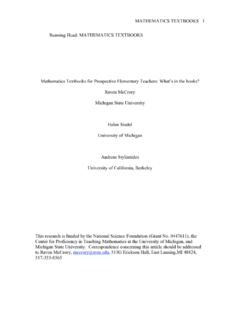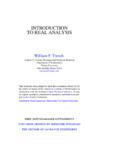Transcription of Undergraduate Texts in Mathematics - …
1 Undergraduate Texts in MathematicsEditorial BoardS. RibetFor further volumes: Daepp Pamela GorkinSecond EditionReading, Writing, and Proving 1 CA Closer Look at MathematicsISSN 0172-6056 Springer New York Dordrecht Heidelberg LondonAll rights reserved. This work may not be translated or copied in whole or in part without the written permission of the publisher (Springer Science+Business Media, LLC, 233 Spring Street, New York, NY tion with any form of information storage and retrieval, electronic adaptation, computer software, or by similar or dissimilar methodology now known or hereafter developed is use in this publication of trade names, trademarks, service marks, and similar terms, even if they are not identified as such, is not to be taken as an expression of opinion as to whether or not they are subject to proprietary on acid-free paperSpringer is part of Springer Science+Business Media ( )Editorial Board: S.)
2 AxlerMathematics RibetMathematics Department University of California at BerkeleyBerkeley, CA 94720 USASan Francisco State Daepp Pamela GorkinISBN 978-1-4419-9478-3 e-ISBN 978-1-4419-9479-0 Library of Congress Control Number: 2011931085 DOI Francisco, CA 94132 Lewisburg, PA 17837 Department of MathematicsBucknell UniversityLewisburg, PA 17837 Department of MathematicsBucknell University10013, USA), except for brief excerpts in connection with reviews or scholarly analysis. Use in connec- Springer Science+Business Media, LLC Hannes and MadeleinePrefaceYou are probably about to teach or take a first course in proof techniques, ormaybe you just want to learn more about Mathematics . No matter what the reason, astudent who wishes to learn the material in this book likes Mathematics and we hopeto keep it that way. At this point, students have an intuitive sense of why things aretrue, but not the exposure to the detailed and critical thinking necessary to survivein the mathematical world.
3 We have written this book to bridge this our experience, students beginning this course have little training in rigorousmathematical reasoning; they need guidance. At the end, they are where they shouldbe; on their own. Our aim is to teach the students to read, write, and do mathematicsindependently, and to do it with clarity, precision, and care. If we can maintain theenthusiasm they have for the subject, or even create some along the way, our bookhas done what it was intended to book was written for a course we teach to first- and second-yearcollege students. The style is informal. A few problems require calculus, but theseare identified as such. Students will also need to participate while reading proofs,prodded by questions (such as, Why? ). Many detailed examples are provided ineach chapter. Since we encourage the students to draw pictures, we include many il-lustrations as well.
4 Exercises, designed to teach certain concepts, are also can be used as a basis for class discussion, or preparation for the class. Stu-dents are expected to solve the exercises before moving on to the problems. Com-plete solutions to all of the exercises are provided at the end of each chapter. Prob-lems of varying degrees of difficulty appear at the end of each chapter. Some prob-lems are simply proofs of theorems that students are asked to read and summarize;others supply details to statements in the text. Though many of the remaining prob-lems are standard, we hope that students will solve some of the unique problemspresented in each bad news is that it is not easy to write a proof well. The good newsis that with proper instruction, students quickly learn the basics of writing. We tryto write in a way that we hope is worthy of imitation, but we also provide studentsviiviiiPrefacewith tips on writing, ranging from the (what should be) obvious to the insider spreference ( Don t start a sentence with a symbol.)
5 Can someone learn to prove mathematical results? There are manytheories on this. We believe that learning Mathematics is the same as learning to playan instrument or learning to succeed at a particular sport. Someone must provide thebackground: the tips, information on the basic skills, and the insider s know-how. Then the student has to practice. Musicians and athletes practice hours a day, andit s not surprising that most mathematicians do, too. We will provide students withthe background; the exercises and problems are there for practice. The instructorobserves, guides, teaches and, if need be, corrects. As with anything else, the morea student practices, the better she or he will become at solving this should be in a book like this one? Even a quick glance atother Texts on this subject will tell you that everyone agrees on certain topics: logic,quantifiers, basic set theoretic concepts, mathematical induction, and the definitionand properties of functions.
6 The depth of coverage is open to debate, of course. Wetry to cover logic and quantifiers fairly quickly, because we believe that studentscan only fully appreciate the fundamentals of Mathematics when they are applied tointeresting is also apparent is that after these essential concepts, everyone disagreeson what should be included. Even we prefer to vary our approach depending on ourstudents. We have tried to provide enough material for a flexible approach. The Minimal you need only the basics, cover Chapters 1 18. (If youassume the well ordering principle, or decide to accept the principle of mathe-matical induction without proof, you can also omit Chapters 12 and 13.) The Usual approach includes Chapters 1 18 and Chapters 21 24. (This is easily doable in a standard semester, if the class meets three hoursper week.) The Algebra an algebraic slant to the course, cover Chapters 1 18,omitting Chapter 13 and including Chapters 27 and 28.
7 The Analysis a slant toward analysis, cover Chapters 1 23. (In-clude Chapter 24, if time allows. This is what we usually cover in our course.)Include as much material from Chapters 25 and 26 as time allows. Students usu-ally enjoy an introduction to metric spaces. have included projects intended to let students demonstrate whatthey can do when they are on their own. We indicate prerequisites for eachproject, and have tried to vary them enough that they can be assigned throughoutthe semester. The results in these projects come from different areas that we findparticularly interesting. Students can be guided to a project at their level. Sincethere are open-ended parts in each project, students can take these projects as faras they want. We usually encourage the students to work on these in groups. word about some of our symbols is in order here.
8 In an attempt tomake this book user-friendly, we indicate the end of a proof with the well-knownsymbolut. The end of an example or exercise is designated by . If a problem isused later in the text, we designate it byProblem#. We also have a fair numberPrefaceixof nonproofs. These are proofs with errors, gaps, or both; the students areasked to find the flaw and to fix it. We conclude such proofs with the symbolut? . Every other symbol will be defined when we introduce you to it. Definitionsare incorporated in the text for ease of reading and the terms defined are given inboldface also hope that students will make the transition to thinking ofthemselves as members of a mathematical community. We encourage the studentswe have in this class to attend talks, give talks, go to conferences, read mathemat-ical books, watch mathematical movies, read journal articles, and talk with theircolleagues about the things in this course that interest them.
9 Our (incomplete, butlengthy) list of references should serve a student well as a starting point. Each of theprojects works well as the basis of a talk for students, and we have included somebackground material in each section. We begin the chapter on projects with sometips on speaking about s new in this have made many changes to the first edition. First,all exercises now have solutions and every chapter, except for the first, has at leasttwenty problems of varying difficulty. As a result, the text has now roughly twiceas many problems than before. As in the first edition, definitions are incorporated inthe text. In this edition, all definitions newly introduced in a chapter appear again ina section with formal statements of the new definitions. We have included a detaileddescription of definitions by recursion and a recursion theorem. We ve added axiomsof set theory to the appendix.
10 We have included new projects: one on the axiom ofchoice and one on complex numbers. We have added some interesting pieces to twoprojects,Picture ProofsandThe Best Number of All (and Some Other Pretty GoodOnes).Some chapters have been changed or added. The first edition s Chapter 12, whichrequired more of students than previous chapters, has been broken into two chapters,now enumerated Chapters 12 and 13. If the instructor wishes, it is possible to simplyassume the results in Chapter 13 and omit the chapter. We have also included a newchapter, Chapter 24, on the Cantor Schr oder Bernstein theorem. We feel that thisis the proper culmination to Chapters 21 23 and a wonderful way to end the course,but be forewarned that it is not an easy to many of you who used the text, we were able to pinpoint areas wherewe could improve many of our explanations, provide more motivation, or present adifferent perspective.

